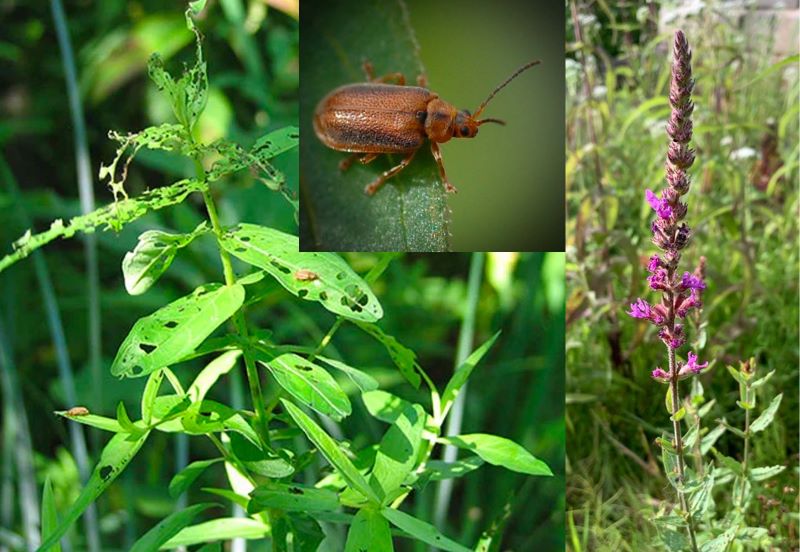by Fred Schueler – Fragile Inheritance Natural History
In the last few weeks, some roadside ditches, fields, and wetlands have been brightened by the blooming spikes of Purple Loosestrife (Lythrum salicaria). This spectacular species is native to Europe, temperate Asia and northwest Africa, and has been introduced widely around the globe, often initially as a garden plant, but soon doing invasively well on its own.
Through the 1980s and 1990s Purple Loosestrife was the poster child of the threat of the newly-conceived idea of invasive alien plants. It used to be thought that continental plant communities were so coadapted that foreign species couldn’t break into them, and the way Purple Loosestrife took over wetlands that were otherwise intact was part of the argument that this wasn’t true.

The Loosestrife grew up to two metres tall, from massive wood-like root systems, with hundreds of thousands of blooms on a single plant, completely dominating entire fields and wetlands, and, as one of my notes from 1996 remarks, “shedding seeds like pollen.”
Study of biological control of Loosestrife began in 1985. After exhaustive study in Europe of other plants they might damage, in 1992 the Canadian and US governments approved the release of two European leaf-eating beetles, Galerucella calmariensis and G. pusilla, to chew down the Loosestrife. Naomi Cappuccino and her students at Carleton Univerisity brought the beetles to eastern Ontario. Two other biocontrol insects have also been introduced, Hylobius transversovittatus, Loosestrife Root Weevil, and Nanophyes marmoratus, Loosestrife Flower Weevil, whose English names describe their habits, and which also weaken the plants though their action is less conspicuous than the leaf-eating of the Galerucella beetles.
In a ditch along County Road 18 just south of Bishops Mills which I monitor as a frog hibernation site, in August of 2003, Loosestrife was “codominant, young 60-70 cm plants in bloom, encroaching with Grass on the ditch,” so abundant that in November I “swept Loosestrife seeds off the ice.” In July 2004, the beetles had arrived, a few plants had “some leaf damage,” many had forked stems, and we found two adult Galerucella calmariensis. In 2005, the control beetles exploded across eastern Ontario, leaving many fields grey with the dead stems of the Loosestrife, and in July, Bird’s-foot Trefoil was expanding into the area of the ditch that used to be dominated by the Loosestrife but now was restricted to “little short stems, and a few stems in upland sites around the intersection in the village.” In 2006, it was “a few stunted plants” and in 2007, “many [were] 10-20 cm tall… leaves riddled or twisted from Galerucella herbivory, but others are just small without any holes in the leaves… where the roadside had been lined with Loosestrife.” This stunted growth continued until 2010, with an “un-beetled plant in the sandy fill behind the General Store, unperforated, 115 cm tall, with massive flowerheads” reminding us what the recent decades had been like.
The first year when Loosestrife recovered somewhat was 2010, when many insect herbivores seemed not to have done well, and the surviving Loosestrife roots in the ditch put up a purple mass of low shoots, displacing the Trefoil in areas where it had become dominant. The Galerucella rebounded, and beat back the Loosestrife until 2017, when, after a dry spring when the beetles had been abundant, a rainy summer seemed to wash the larvae off the plants, unleashing them to grow tall and bloom, leading many people to remark on the invasiveness of the species.
In 2018, there were few of the beetles in the spring, but they exploded during the summer, leaving “plants in ditch moderately forked & moderately perforate,” even after mowing of the roadsides, showing that the Galerucella weren’t set back by roadside mowing. The Loosestrife was severely chewed back in 2019, but recovered somewhat in 2020 and 2021. Last year, I recorded “short plants forked & heavily perforate from Galerucella.” This year, there was lots of beetle damage in the spring, favoured by the dry period in May, and there’s a moderate bloom of Loosestrife in many areas, probably promoted by heavy recent rain.
If you see Loosestife that’s less than a metre tall, you’re seeing evidence of the effectiveness of the insect biocontrol of the species, but the Loosestrife roots are persistent and beetle populations fluctuate from year to year and between different areas and habitats. There are low islands in the Ottawa River which are still solidly purple, and we assume that the beetles can’t get established there because they can’t overwinter under water. This means that while the Loosestrife is “under control,” it’s still an “abundant naturalized wildflower,” and will be conspicuous for the foreseeable future.





